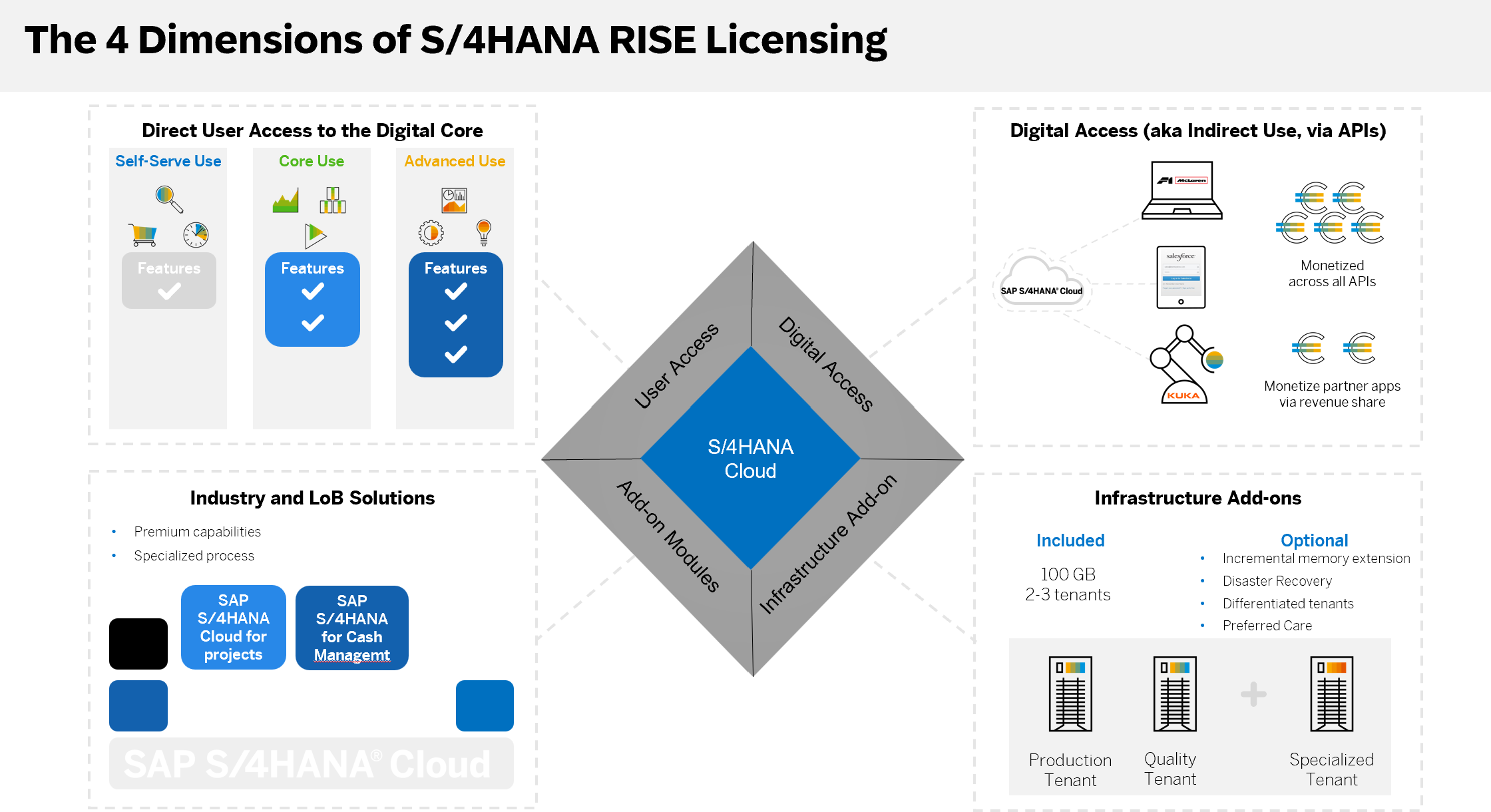- 1. Introduction
- 2. What is RISE with SAP? What Does It Mean for Your Business?
- 3. What's Included in RISE with SAP?
- 4. Contract Dynamics of RISE with SAP
- 5. Overview of the Dimensions of S/4HANA RISE Licensing
- 6. RISE with SAP S/4HANA Cloud Offerings
- 7. Evaluating RISE with SAP Packages
- 8. Understanding the Full Use Equivalent (FUE) Licensing Model
- 9. T-Shirt Sizes and System Allocation in SAP S/4HANA Cloud, Private Edition
- 10. Technical Differentiation Between RISE with SAP Private Cloud and On-Premise/Hosted Solutions
- 11. How LDS Can Help Businesses
- 12. Final Thoughts
Introduction
If you're already an SAP customer, there's a good chance that SAP has either talked to you about RISE or will bring it up in 2025. The joke is that nowadays, even if you went to SAP to buy a book, they'd offer you a RISE proposal instead! RISE is a top priority for SAP—it's where their sales team commission is focused, and the company is betting big on it for the future. That's why it's critical for you to understand what RISE is and whether it makes sense for you or not.
RISE with SAP, launched in early 2021, is promoted as a service to help businesses move their ERP systems to the cloud and simplify operations within SAP's ecosystem. However, it’s important to note that RISE isn’t a revolutionary new product like the 2011 launch of SAP S/4 HANA, which introduced entirely new capabilities. Instead, RISE is more of a rebranding, repackaging, and bundling of existing SAP S/4 HANA products and services, with some new features added.
At its core, RISE changes the way SAP services are managed. Instead of customers handling their own SAP hosting and basic services, SAP takes over some of these responsibilities. Previously, businesses had to negotiate separate contracts for software licenses, hosting, and some parts of management services. RISE simplifies this by bundling everything into a single subscription-based contract. However, this shift requires careful consideration to ensure the new RISE contract/BOM fits a company’s needs, budget, and long-term goals.
It’s crucial to fully understand the potential challenges of adopting RISE, such as increased long-term OPEX costs, dependence on SAP as the sole provider, and the limitations or exclusions within the RISE packages. This blog post aims to help SAP customers clearly understand what RISE with SAP includes—and what it doesn’t. Whether you’re just exploring the option or preparing to make the switch, this guide provides practical insights to help you make informed decisions.
What is RISE with SAP? What Does It Mean for Businesses?
RISE with SAP is a consolidated suite of software, tools, and services designed to assist businesses in transitioning their existing ERP systems, such as SAP ECC or SAP S/4HANA, from on-premise setups to the cloud-based environment. This offering combines hosting, applications, regular upgrades, migration services, and built-in security and support into a single subscription contract. By consolidating all aspects of the solution, RISE with SAP aims to eliminate the complexity of managing multiple vendors, contracts, and systems.
What is Included in RISE with SAP?
Switching to a RISE with SAP contract means moving away from owning software licenses and maintenance agreements to a single subscription model. This subscription covers access to SAP S/4HANA Cloud, some technical management services (we’ll discuss later what SAP handles versus what you’re responsible for), and the flexibility to choose your preferred cloud provider, like Azure, AWS, or Google Cloud. You can also pick a Systems Integrator (SI) that fits your specific needs. Here’s a breakdown of what’s included:
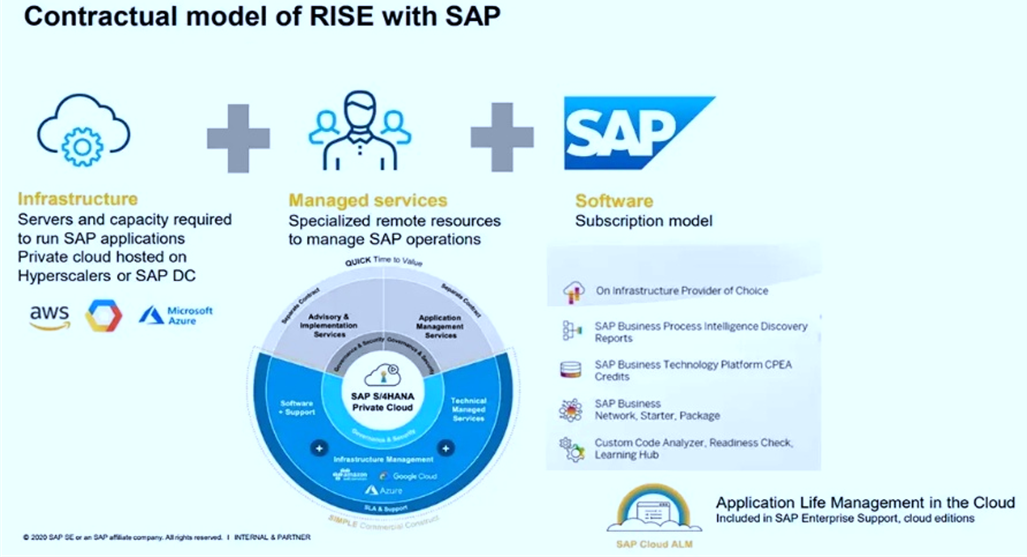
Below is a high-level overview of the key components of RISE with SAP, which we will review in detail later.
-
i. SAP S/4HANA Cloud:
-
GROW with SAP (Public Cloud): GROW with SAP is aimed at new and existing small customers who want to start fresh with a cloud-based ERP system. It offers SAP S/4HANA Cloud Public Edition, a ready-to-use solution that follows industry best practices and is regularly updated with new features. This system runs on shared cloud infrastructure managed by SAP and is ideal for small to medium-sized businesses that need a quick and straightforward setup. However, GROW with SAP does not allow for customization.
-
RISE with SAP (Private Cloud): This allows you to customize your SAP Environment within a dedicated private cloud setup, ensuring your system resources are not shared with other customers. This is the most popular RISE offering and is ideal for large and medium-sized enterprises, especially those currently using ECC and looking to transition to S/4 HANA.
-
-
ii. SAP Business Technology Platform (BTP): With the introduction of RISE, SAP has taken a U-turn in its approach to customizations. To innovate quicker, SAP is promoting the concept of a "clean core," where the core system remains standard and custom requirements are handled outside. To support this, SAP has developed the BTP platform.
At its core, BTP acts as an integration hub, providing tools for data management, analytics, application development, automation, and AI across the organization. However, many customers misunderstand or overlook its importance. For those planning to adopt RISE, understanding, embracing, and leveraging BTP is essential as it is a key component of a successful RISE implementation.
-
iii. SAP Business Network: This enhances collaboration across procurement, supply chain, logistics, and asset management. Within the RISE with SAP contract, businesses are allocated 2K Ariba Network documents, which provide initial connectivity for streamlined operations.
-
iv. SAP Business Process Intelligence (BPI): BPI tools help organizations analyze and optimize their existing processes before migrating to S/4HANA Cloud. This component includes:
-
SAP Signavio: Facilitates the mapping and reengineering of workflows to improve efficiency.
-
Process Discovery Reports: Identifies inefficiencies and provides actionable insights to enhance business performance.
-
-
v. Service Level Agreements (SLAs) for RISE with SAP: RISE with SAP offers Service Level Agreements (SLAs) customized for different industries and deployment needs. For example, banks might have stricter performance and compliance standards than industries like manufacturing or retail. These SLAs are designed to meet the specific needs and regulations of each sector, with pricing and terms adjusted to match. A common difference in SLAs is uptime guarantees—like 99.7% vs. 99.9%—and additional disaster recovery (DR) requirements.
Services Not Covered in RISE with SAP
The RISE with SAP contract does not include:
-
Advisory and Implementation Services: Required for initial system setup, migration, and customization.
-
Application Managed Services: Ongoing functional support for ERP customizations, integrations, and maintenance.
These services must be procured separately through SAP implementation partners or third-party providers. It is important to carefully review SLAs, governance structures, and clarify responsibilities between SAP and its partners to avoid potential issues.
Contract Dynamics of RISE with SAP
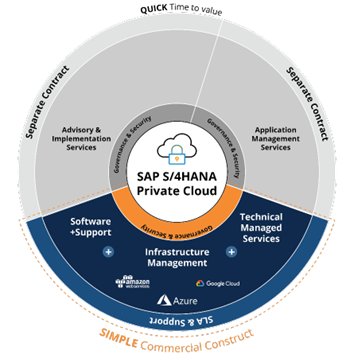
Services Included in the RISE with SAP Contract
-
1. Software Licenses: Licensing for the core ERP system, SAP S/4HANA Cloud, is included in the contract.
-
2. Infrastructure: Organizations can choose to host their S/4HANA Cloud ERP on one of the following options:
-
Public cloud providers such as Microsoft Azure, Amazon Web Services (AWS), Google Cloud Platform (GCP)
-
SAP’s data centers.
-
It is important to understand that under the new RISE paradigm sizing for the Infrastructure is tied to the quantity of software licenses, and additional capacity can be purchased as an add-on.
-
-
3. Technical Managed Services: SAP oversees the technical operations of the ERP system, including:
-
System updates
-
Patch management
-
System availability
-
These services enable IT teams to focus on strategic activities while ensuring the ERP system operates smoothly.
Overview of the Dimensions of S/4HANA RISE Licensing
SAP’s licensing model includes four key areas that address various aspects of access, licensing, and deployment:
-
1. Direct User Access to the Digital Core:
-
These are the users who interact with the Digital Core daily (similar to professional users, limited users, self-service users, and developers in the old SAP ECC contract model).
-
Understanding your user requirements is crucial because it determines the "T-shirt size" of the cloud-based hardware you'll need. For more details, check out the FUE section below or read our blog on FUE.
-
-
2. Digital Access (Indirect Use via APIs):
-
Indirect Digital Access is not included in RISE base licensing and needs to be procured separately.
-
Covers non-SAP interactions with S/4HANA through APIs, including third-party applications, bots, and integrations.
-
SAP charges based on relevant documents created, with costs increasing depending on the volume.
-
Organizations should monitor Non SAP API usage closely to manage licensing costs effectively.
- Please read our blog post on Indirect Access:
-
-
3. Industry and Line-of-Business (LoB) Solutions:
-
Specialized solutions tailored for specific industries or advanced business processes.
-
Examples include project management tools, cash flow management, and other sector-specific functionalities.
-
-
4. Infrastructure Add-Ons:
-
The number of users (FUE) you need will determine the amount of cloud infrastructure included, but if you require more, you can purchase additional resources.
-
Options like extra memory, additional application servers, or extra tenants are available to customize your infrastructure.
-
These add-ons are optional and offer flexibility to meet your business needs.
-
RISE with SAP S/4HANA Cloud Offerings in Detail

As discussed above, when considering RISE with SAP, businesses have two main deployment options for S/4HANA Cloud: Private Edition and Public Edition. Below is a comparison to help determine which option best suits your organization's needs:
Public Cloud (SaaS)-GROW:
-
1. Limited Customization: Focuses on standardized business processes with minimal customization.
-
2. Restricted Deployment Options: Deployment is confined to SAP data centers, limiting flexibility in infrastructure choices.
-
3. Potential Cost Savings: Generally more cost-effective than the private cloud, making it suitable for businesses seeking faster implementation and adherence to SAP’s standard templates.
-
4. Shared Infrastructure: Operates on a multi-tenant model where resources are shared among multiple customers.
-
5. Customization Limitations: Limited access to SAP core, restricting deeper customizations and modifications.
Private Cloud-RISE:
-
1. Greater Customization Flexibility: Allows for extensive customization, enabling businesses to tailor the solution to unique processes.
-
2. Deployment Options: Can be deployed on hyperscalers such as AWS, Azure, Google Cloud, or within an organization’s own data center, offering greater versatility.
-
3. Higher Cost: Includes a broader range of features than the public cloud, typically coming at a higher cost.
Evaluating RISE with SAP Packages
RISE with SAP packages have been designed to better support organizations transitioning to the cloud with a customizable cloud ERP solution. Customers can select from Base, Premium, and Premium Plus editions, with optional add-ons for specialized capabilities.
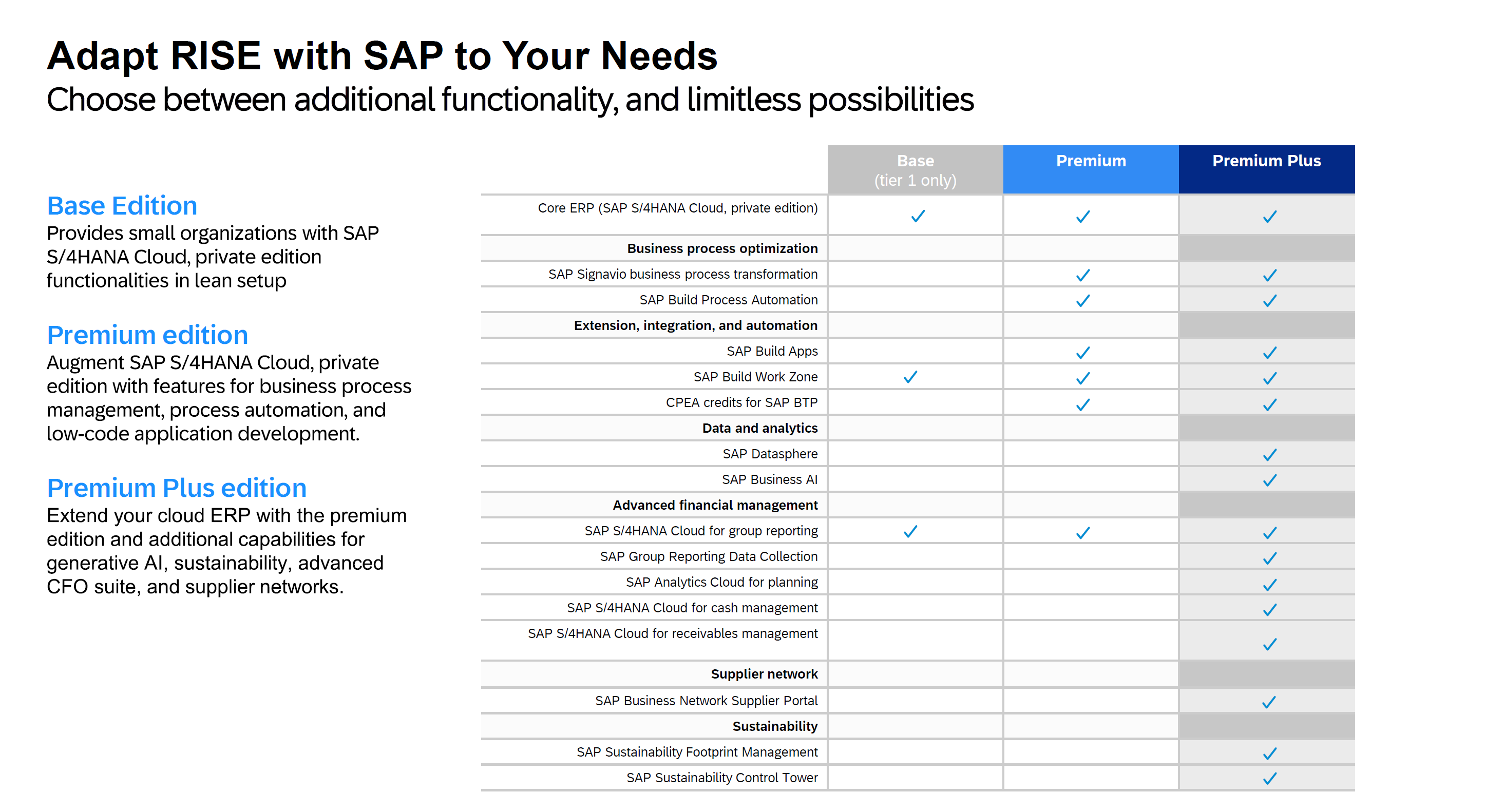
-
Base Edition: Suitable for less complex organizations, Base Edition offers SAP S/4HANA Cloud Private Edition with a streamlined setup. This includes basic work zone functionality and group reporting. However, it provides limited entitlements. Organizations requiring advanced capabilities or more customization may find this package insufficient.
-
Premium Edition: This builds on the Base Edition by introducing enhanced functionalities such as process automation and low-code business application development. It includes tools for process optimization, workflow automation, and enhanced access to SAP Business Technology Platform (BTP) services through Cloud Platform Enterprise Agreement (CPEA) credits. This is the most popular edition and is widely used by our enterprise customers.
-
Premium Plus Edition: The most extensive offering, this edition expands on the Premium Edition by providing additional AI scenarios, sustainability scenarios, and advanced financial management capabilities. It includes tools for AI capabilities, data management, procurement, and sustainability tracking. The Premium Plus Edition also offers extensive functionality for cash management, receivables management, group reporting, and integration with SAP Analytics Cloud for planning and analytics.
SAP S/4HANA Cloud Private Cloud Packages
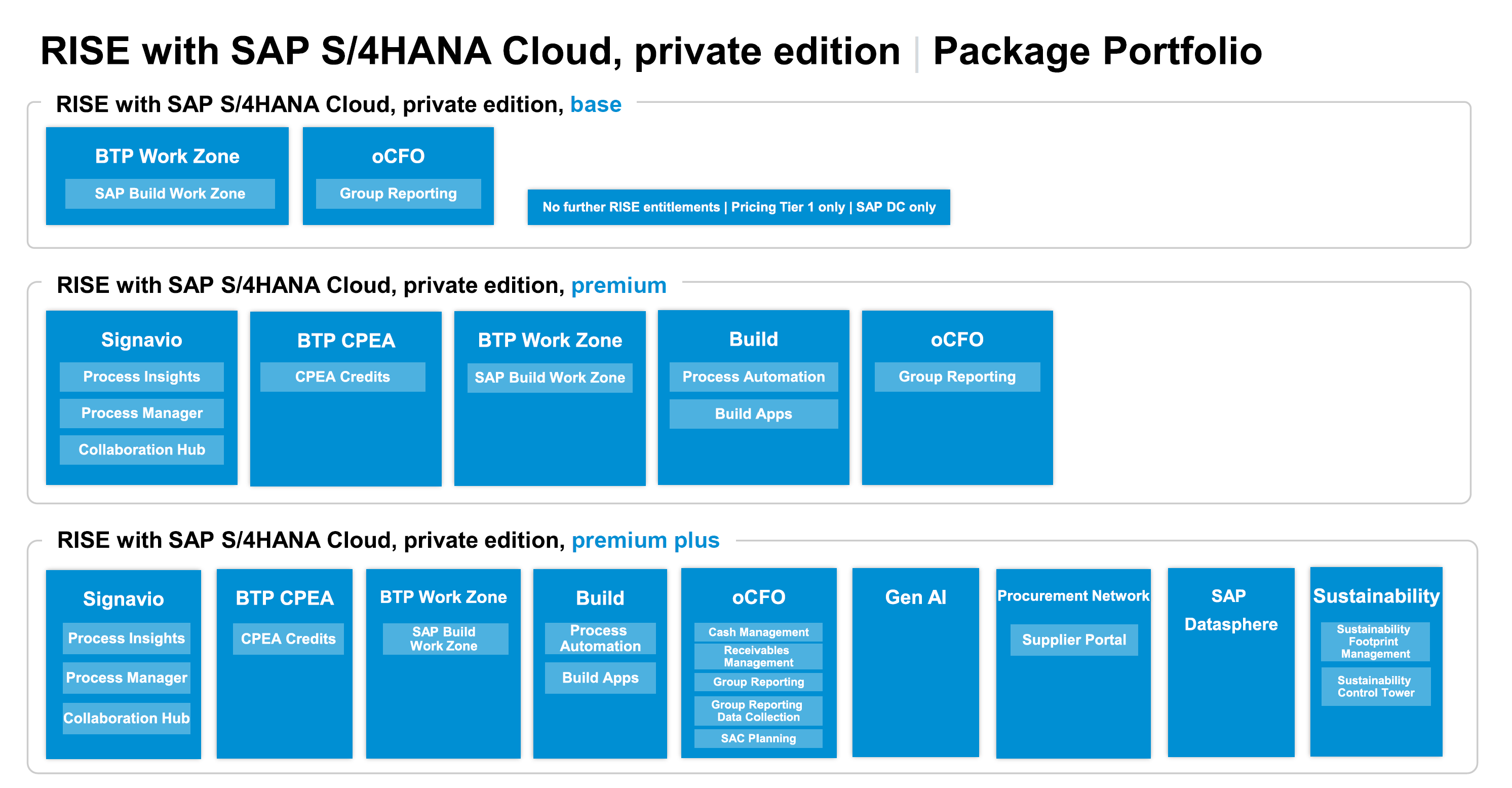
Here’s a breakdown of the three packages offered under the RISE with SAP S/4HANA Cloud, private edition:
Base Package
-
Core Offering: Includes essential components of SAP S/4HANA Cloud, private edition.
-
Basic Features: Provides fundamental ERP functionalities and some Group Reporting capabilities.
-
Centralized Applications: Allows the creation of sites to centralize enterprise applications.
Premium Package
-
Enhanced Offering: Includes everything in the Base package plus additional features.
-
Original Components: Contains the original components of RISE with SAP, such as SAP Business Network Starter Pack, consumption credits for SAP Business Technology Platform, and SAP Signavio’s business process transformation tools.
Premium Plus Package
-
Comprehensive Offering: The most advanced package, including all features from the Premium package.
-
AI and Sustainability: Adds generative AI capabilities and sustainability innovations, such as AI tools like SAP's AI copilot Joule for smarter insights.
-
Advanced Finance Solutions: Offers enhanced financial planning, improved forecast accuracy, and better invoice management and cash collection processes.
For a clearer understanding, please refer to the table outlining the inclusions of each package.
Take a look at this breakdown of entitlement details for RISE with SAP S/4HANA Cloud, private edition, premium. It gives you the user limits for different SAP Build services, and other offerings like SAP Datasphere, Joule, and Cloud Services.
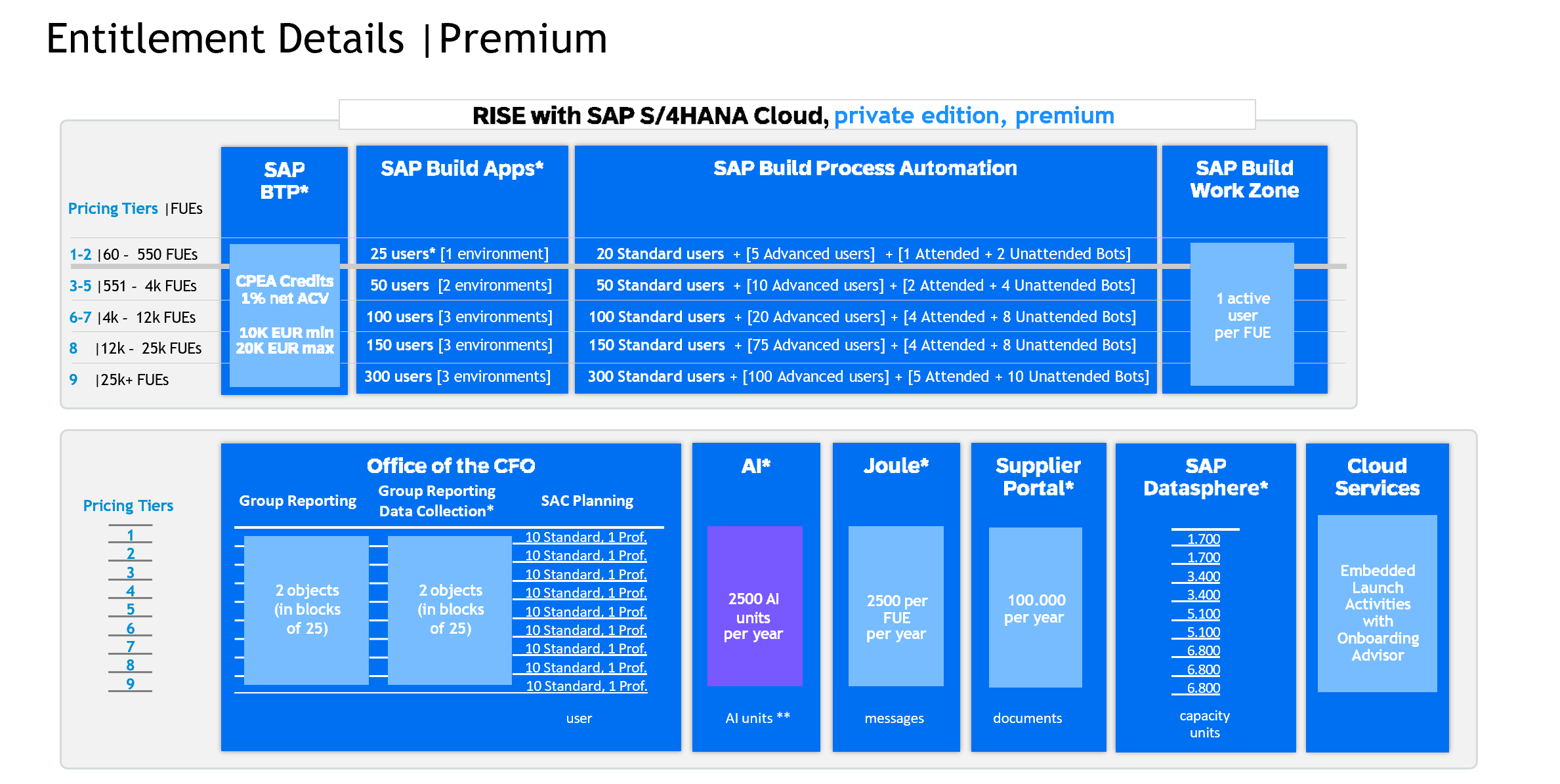
Understanding Full Use Equivalent (FUE) Licensing Model
Full Use Equivalent (FUE) model is a licensing method that determines how businesses allocate access to SAP S/4HANA Cloud services based on predefined ratios. It sounds straightforward, but its structure hides complexities that can cause operational inefficiencies, compliance risks, and spiraling costs if misunderstood. Let’s demystify this system step-by-step.
What is an FUE?
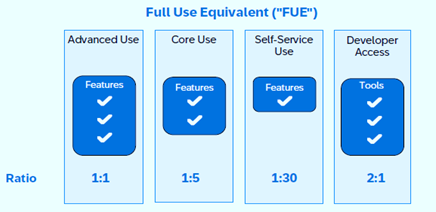
An FUE is SAP’s way of measuring user access to its cloud services. Instead of assigning licenses directly per user, SAP uses FUEs as a "currency" to standardize access levels for different types of users. Each FUE represents a unit of resource consumption, with specific ratios applied depending on the user's role and access needs.
How Does the FUE System Work?
FUEs are allocated based on user roles, which SAP categorizes into four main types:
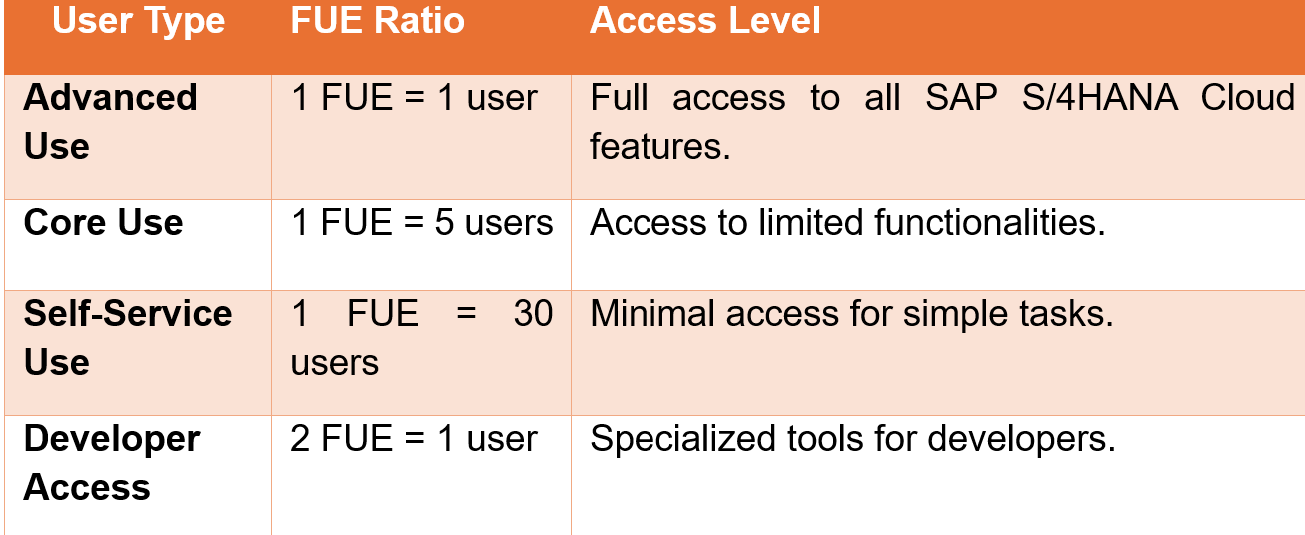
Key Concepts of FUE Allocation
-
1. Allocation: Businesses can assign their pool of FUEs to any combination of these user types, depending on their needs.
-
2. Reallocation During Subscription: FUEs can be reassigned to different user types as roles change. For instance, if a user shifts from core use to advanced use, FUEs can be reallocated to reflect this change.
-
3. Ratios Dictate Cost and Resources: Advanced use requires significantly more FUEs than self-service use, meaning organizations must carefully plan to avoid overcommitting resources to high-consumption roles.
Breaking Down the Access Types
-
Advanced Use (1 FUE per User): Grants unrestricted access to all S/4HANA Cloud features. Ideal for roles that require full system capabilities, such as financial controllers, high-level managers, and administrators.
-
Core Use (1 FUE for 5 Users): Provides moderate access, suitable for operational roles that don’t require full functionality, such as mid-tier managers or department heads.
-
Self-Service Use (1 FUE for 30 Users): Offers very limited access, typically for employees who interact with the system occasionally to perform basic tasks, such as entering time logs or accessing personal data.
- Developer Access (2 FUE per User): Reserved for software developers using SAP’s development tools. Developer roles consume twice as many FUEs, reflecting their specialized nature.
For more information, read our detailed blog post here.
Understanding T-Shirt Sizes and System Allocation in SAP S/4HANA Cloud, Private Edition
This concept represents a new paradigm that many customers may not fully grasp. The T-shirt sizing model is a method used by SAP to allocate system resources to organizations based on their specific workload requirements. This approach assigns predefined sizes, ranging from XXS to XXL, to provision a 3-tier landscape infrastructure. Each size is associated with specific hardware configurations, such as the amount of RAM and the number of application servers, across Production (PRD), Quality Assurance (QAS), and Development (DEV) environments.
It is crucial for customers to thoroughly understand this model. If environments are not sized correctly, organizations may face issues such as capacity deadlocks, unexpected additional capacity costs, or, in the worst-case scenario, over-provisioned resources. This challenge arises due to the direct relationship between capacity and the Fixed User Equivalent (FUE) metric.
T-Shirt Sizes and Full User Equivalent (FUE)
SAP assigns T-shirt sizes to organizations based on their Full User Equivalent (FUE) usage tier. The FUE metric measures the scale of users and workload to ensure customers receive infrastructure that aligns with their requirements.

*Note: No QAS system tier is provided for XXS.

Application Server Allocation by System Size
The Primary Application Server (PAS), a critical component of the SAP infrastructure, handles application processes in each environment (PRD, QAS, and DEV). System sizes dictate how RAM and application servers are distributed across environments.
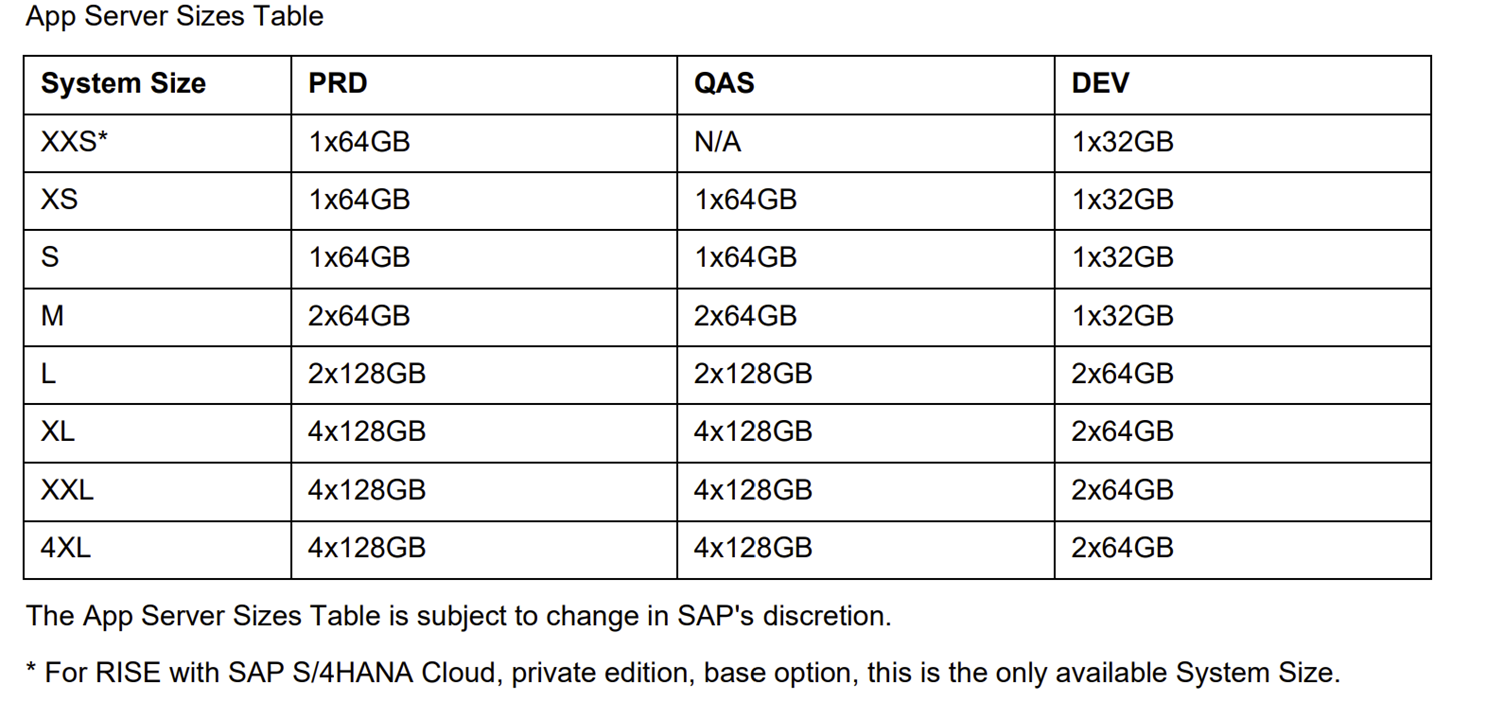
RISE with SAP offers fixed system sizes with caps on RAM and servers, which can limit scalability for rapidly growing businesses. To increase capacity, additional resources can be purchased, but this incurs extra costs and may lead to provisioning delays. Organizations must plan growth carefully to avoid operational constraints.
Technical Differentiation Between RISE with SAP Private Cloud and On-Premise/Hosted Solutions
The table below highlights the key differences between RISE with SAP Private Cloud and traditional on-premise or hosted solutions. It provides a comparative view of included services, responsibilities, and additional features offered under the RISE with SAP Private Cloud model versus customer-managed setups.
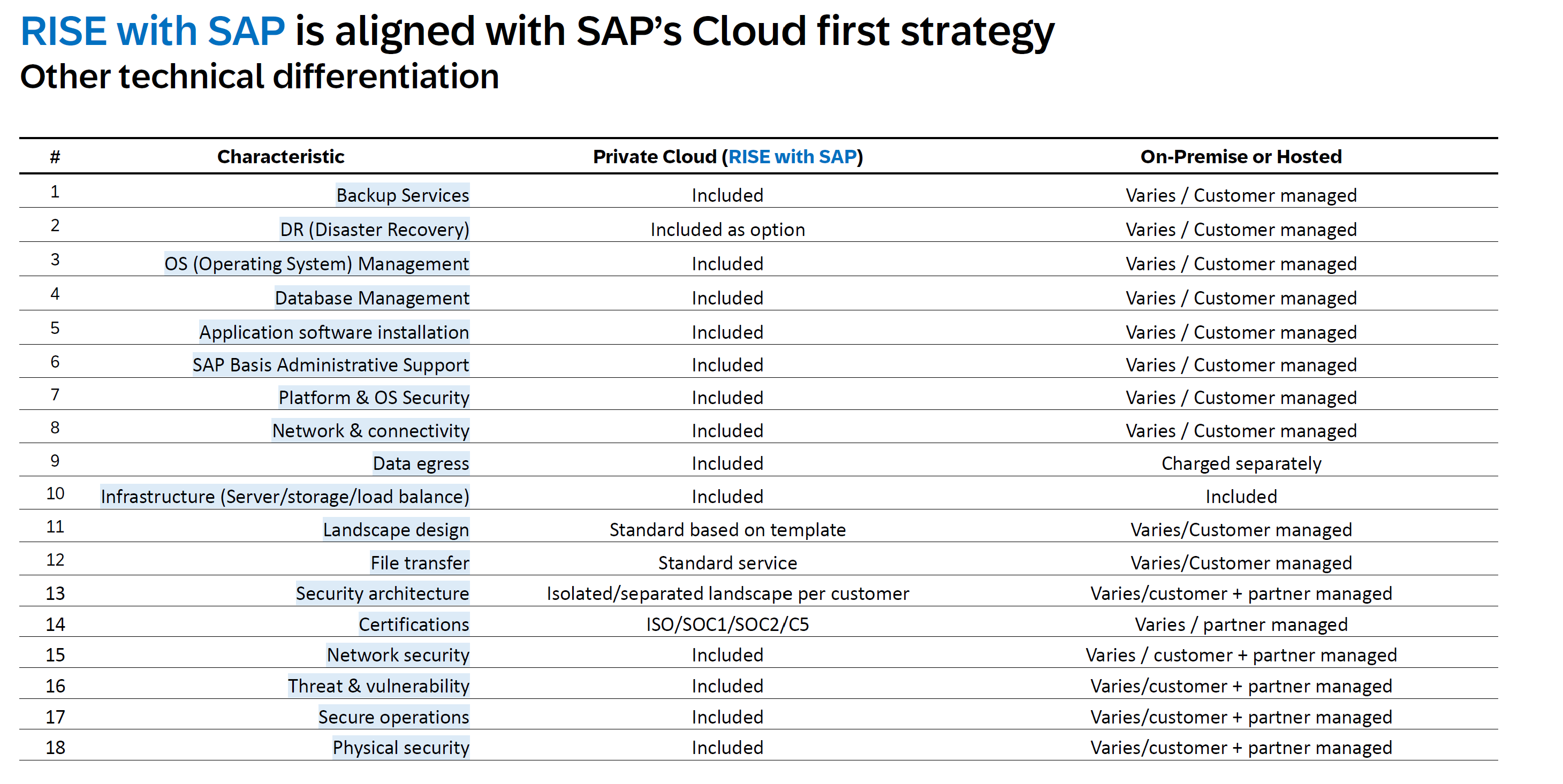
-
1. Backup and Disaster Recovery (DR): Backup services are included in the private cloud, while DR is offered as an option. On-premise or hosted solutions require customers to manage these components.
-
2.Operating System (OS) and Database Management: Fully included in the private cloud offering, ensuring SAP handles these aspects. In contrast, customers or partners manage these services in on-premise/hosted environments.
-
3. Application Software Installation and SAP Basis Support: These services are standard in the private cloud model but require customer management in other setups.
-
4. Platform, Network, and Infrastructure: The private cloud includes platform and OS security, network connectivity, and infrastructure-like servers and storage. On-premise/hosted solutions depend on customer or partner management, with some services charged separately (e.g., data egress).
-
5. Standardized Design and Security: The private cloud offers a standardized landscape design, security architecture, and compliance certifications (e.g., ISO/SOC1/SOC2/C5). These features vary or depend on external oversight in customer-managed environments.
-
6. Physical and Network Security: The private cloud ensures all aspects of security are included, while on-premise setups may require varying levels of customer or partner involvement.
This comparison is crucial for businesses evaluating whether to adopt RISE with SAP or continue with traditional on-premise models. The differences in management responsibilities and included services can significantly influence operational efficiency and cost considerations. Please review these aspects carefully to avoid potential issues.
How Can Licensing Data Solutions Help You Navigate Your RISE Journey?
Licensing Data Solutions has supported numerous customers on their RISE journey, leveraging the expertise of 40 SAP licensing professionals, including former GLAC auditors and former SAP sales personnel.
Licensing Data Solutions (LDS) offers a range of services aimed at optimizing and assisting customers move to RISE.
Conducting an Enterprise License Position (a.k.a. assisting customers in establishing a baseline for true demand and consumption):
-
a. Understanding What's Being Used: Since SAP often changes product names, this process provides a detailed, accurate analysis of what the customer is using and not using in their environment. This information can be used confidently to request a credit from SAP when switching to RISE. We've seen customers skip this step, and when they ask for a credit, SAP often gives them less than expected or audits them, uncovering bigger compliance issues. SAP then uses these issues to push them towards RISE without offering any discounts.
-
b. Supporting the RISE Contract: The analysis creates a foundation for mapping the customer's environment to the RISE BOM (Bill of Materials).
-
c. Ensuring Independent Analysis: Instead of relying on SAP to perform the analysis, customers get an independent assessment. This is useful even if they don’t switch to RISE, as SAP might otherwise use compliance concerns to pressure them into moving to RISE.
-
d. Using Familiar Tools: We estimate future RISE FUE consumption and other capacity needs using the same tools( Like STAR, DAES, etc) and methods that SAP uses. Unlike SAP sales reps, whose commissions depend on selling specific SKUs, we have no incentive to over project any particular product.
-
e. FUE is one of the largest expenses in a RISE agreement. LDS helps organizations cut these costs by:
-
Optimizing Licenses: Identifying individuals or teams who could work with a cheaper license like a self-service user.
-
Spotting Unused Software: Rightsizing users based on usage and not role allocation.
-
By addressing these issues, companies can eliminate unnecessary spending and save significantly on their future RISE agreement.
Simulating FUE Usage and Capacity in the Future RISE Contract
Full Use Entitlement (FUE) plays a crucial role in SAP contracts. LDS provides services to simulate how FUE would apply to a RISE (SAP’s transformation solution combining S/4 HANA, technology, and services) contract, helping customers understand how they can maximize value from their contract and avoid over-usage or under-usage penalties.
Mapping the RISE Bill of Materials (BOM) to Old ECC/S/4 Contracts
The RISE agreement encompasses a wide array of components, such as cloud services, subscriptions, and software. LDS assists in mapping these components to the current contracts, ensuring alignment between the RISE BOM and existing SAP entitlements. This mapping ensures that customers receive a comprehensive view of their entire SAP usage, preventing any missed licensing elements. We make sure the quantities we recommend match the customer's current and future needs, not the sales targets of SAP reps
Mapping Current Contracts Back to RISE BOM
Similarly, LDS can map existing contracts back to the RISE BOM, validating that nothing is overlooked. This ensures that all contractual obligations are captured, reducing the risk of compliance issues and financial penalties from SAP due to licensing misalignments. We have seen SAP conveniently forgetting many SKUs from the old ECC contract to the new RISE BOM because the sales rep is not getting any commission on it.
By addressing these areas, LDS helps companies gain a clearer understanding of their SAP usage and optimize their licensing agreements to reduce unnecessary expenses while ensuring compliance with SAP’s terms.
Final Thoughts
The RISE with SAP contract is a unique, one-time opportunity to secure valuable credits and optimize a complex agreement that will impact your business for years. Success with RISE requires teamwork and expert guidance. Customers that achieve the best results are those working with experienced professionals like Licensing Data Solutions who understand the process inside and out. These experts know what to ask for, details customers often miss, the true value of credits, and the fine print in RISE agreements. SAP focuses on selling the RISE deal and maximizing its individual commission, even though it pretends to be unlikely to share these critical insights with customers.
Based on our observations, it is essential for businesses to recognize that migrations take time and should be meticulously planned. To avoid future compliance issues, a thorough understanding of RISE with SAP's evolving requirements is critical. Businesses should take a proactive stance and avoid allowing SAP to dictate the terms of RISE negotiations, as this can lead to imbalanced agreements that may not fully align with their operational and financial interests.
Additionally, it is crucial to clearly define responsibilities—distinguishing between what is managed by SAP and what remains within the organization’s control. By addressing these key points, businesses can take a more balanced and strategic approach to their RISE journey, minimizing risks while maximizing success.
For expert guidance and support in navigating your RISE with SAP journey, please contact This email address is being protected from spambots. You need JavaScript enabled to view it. today.
Also read more on this:
Unleash the Power of SAP Licensing: Top 5 Strategies for Substantial Savings
Comprehensive Guide to Choosing the Perfect SAP HANA License for Your Business
Decoding Sap Fue: A Comprehensive Guide To Full Usage Equivalents
SAP Enhanced Vs SAP Basic Software Licensing Audit
Comprehensive Guide to SAP Indirect Access and How to measure Digital Access in 2025t
Understanding Licensing and Cost Shift from SAP Solution Manager (SolMan) to Cloud ALM (CALM)t
Please check our SAP Licensing Services

